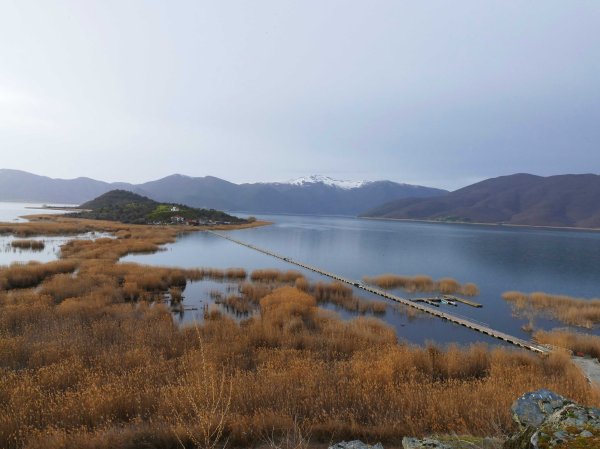
British naturalists have been well aware of the avian riches of Lake Prespa for many decades. Yet I doubt today if one in 100 of those going on a wildlife holiday to Greece have ever visited. It is odd, especially since Prespa has a list of over 260 bird species, more plants than are on the British list and almost three times the number of butterflies. The place also supports some of the rarest birds in the world, with the largest breeding colony of Dalmatian pelicans found anywhere on Earth.
Another wildlife guide observed recently that had Prespa been ‘less remote it would be crammed with visitors coming for the scenery as much as for the birds’. Yet on most days you see no one but locals. It is perhaps this isolation that explains why it is overlooked, but also the appeal of the place once you get there.
Let’s take these two issues separately but first some clarification. What we call ‘Lake Prespa’ is, in truth, two lakes – technically they are Megali and Mikri Prespa, ‘Greater’ and ‘Lesser Prespa’, known together as Prespes. (British visitors usually refer to the site in the singular and I have deferred to that tradition.) The lake basin lies right at the edge of the country close to Greece’s borders with Albania and the Republic of Macedonia.
Getting there takes at least 3-4 hours driving from the nearest major airport (Thessaloniki) and until recently crossing into the other countries was fraught with difficulty. This is an issue because much of the basin is actually in the Republic of Macedonia and the larger of the two Prespa lakes is divided unevenly between all three countries. Only Lesser Prespa, which is much shallower than its neighbour and, at more than 50km2, less diminutive than its name suggests, is primarily in Greece. It is however the single richest spot for wetland birds in the national park.
Unfortunately, the final stretch of road to reach the place requires mounting a steep hill range via a series of lethal hairpin bends. By the time you negotiate the last stretch the whole excursion has acquired a sense of journeying to the end of the world. It is only when you round a final corner and see this high-altitude lake unfurl in quaking blue that you appreciate why you made the effort.
Prespa is astonishingly dramatic, not only because it is so vast, but also because it is ringed around by a towering amphitheatre of mountains. While the place is celebrated for its wildlife often you are just captivated by its changing moods: as the sun rises or sets, or as the clouds pass or if, like me, you go regularly, then as the seasons rotate. At all times it seems to shift before your eyes.
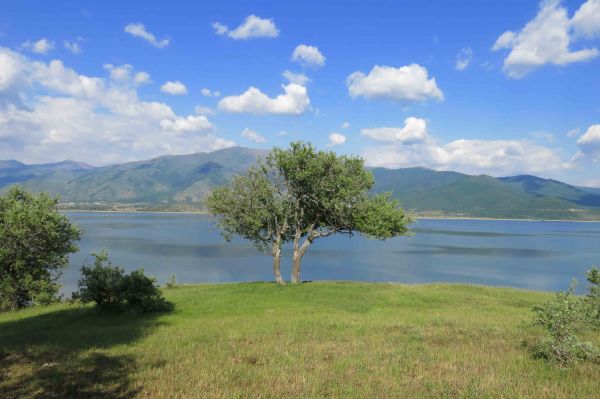
here is Lesser Prespa in full morning glory in May
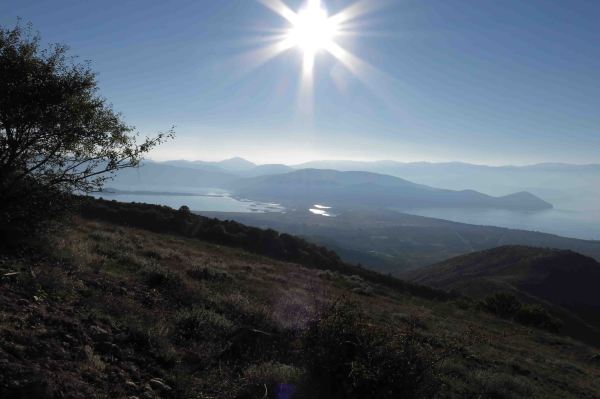
Here it is again on a sultry September afternoon
Above all this place feels like really big country and just the sort of location to hold some of the biggest birds in Europe. A spot I love to launch any visit is a small limestone knoll called Krina that commands views over the whole reed swamp on Lesser Prespa’s northern shore. This is where the main colonies of waterbirds are located and in spring they are everywhere.
The small floating islands close to shore are packed tight with birds including the breeding Dalmatian pelicans. For once the news on this globally threatened species is extremely encouraging. Since the turn of the century the population estimate for the site has more than doubled, from 550 to 1200 pairs. Prespa is also one of the few places in Europe where this giant of a bird, with its three-metre-plus wingspan, breeds together with its even larger sibling the Great White Pelican (c350 pairs).
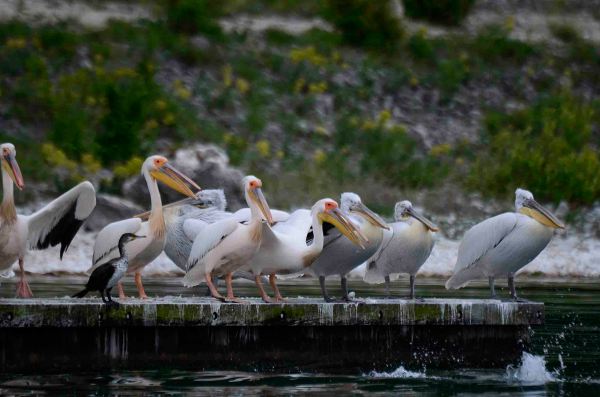
the pink-breasted birds with orange or cherry-red face patches are white pelicans, while the greyer ones are Dalmatian pelicans
Direct comparison of the two is a commonplace part of pelican watching and the birds are also tame, often sitting on jetties or pottering among the boats moored at the lakeside villages such as Psarades. By late morning they also present a more graceful vision because they rise on thermals over the walls of the encircling mountains, spiraling outwards to feed across the lakes of northern Greece.
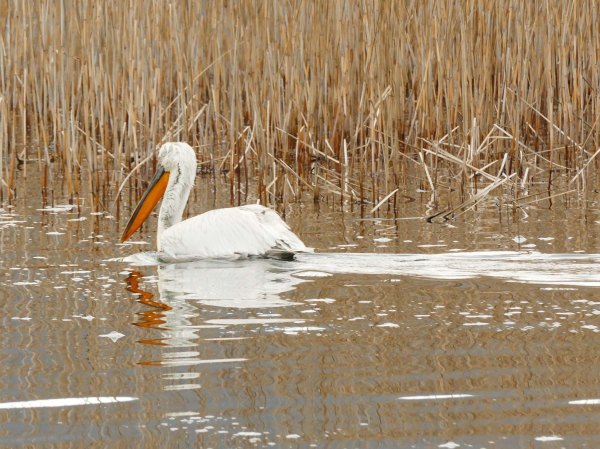
Dalmatian pelican in full fig (note the extraordinary orange bill). The breeding dress develops very early since they can start breeding in February
The two pelicans may be among Prespa’s headline attractions, but everywhere you look at this site you are confronted with large waterbirds powering out to feed in all parts of the lakes. These include purple and grey herons, great cormorants, great and little egrets, and also a range of smaller birds that prefer the dense reed fringes, such as squacco herons, black-crowned night herons and little bitterns. These three are often elusive or scarce elsewhere, but at Prespa they are common and remarkably confiding. Two further attractions are both classified as near-threatened. They are ferruginous duck, which breeds in small numbers, and the range-restricted pygmy cormorant, which has a breeding colony of up to 700 pairs and is ubiquitous.
The northern Pindos mountains of Greece have experienced successive waves of human emigration in the last half century and this border area is now among the most depopulated parts in all Europe. It is the locale for an inadvertent rewilding experiment and now holds some of Europe’s best populations of brown bears and wolves, both of which pass through Prespa on a routine basis. But don’t hold your breath; they are remarkably elusive and friend and resident naturalist Julian Hoffman has seen them only twice in 15 years.
For all its remote wildness Prespa offers the possibility of irrigated agriculture in the basin and this has paved the way for an intensive form of bean farming. As a result there are several substantial agricultural villages, including Agios Germanos, which is about 10 kilometres from the best wetland area. It is the prefect base for a visit, not only because it has great restaurants but also because the birding around there and all the way through the agricultural hinterland almost to the lake shore offers great opportunities.
Four Dendrocopos – Syrian, great, middle and lesser spotted woodpeckers – are regulars in the town’s many orchards, while the fizz of singing black redstarts is constant, as is the chortling of red-rumped swallows or crag martins. Spring brings singing red-backed, lesser grey and woodchat shrikes to the farmland nearby, not to mention golden orioles, common nightingales and subalpine warblers.
Come autumn the wooded isthmus of land that separates the two lakes is a great spot for migrants. In September it can be thick with passing spotted flycatchers, willow warblers and hirundines, while large mixed ‘flava’ wagtail flocks muster and swirl across the fields like chaff raised in a breeze. The cliffs at the western edge of the spit also holds breeding Eurasian eagle owl, while the reedbeds in this area are often alive with bearded reedlings and penduline tits.
The whole stretch is always worthy of exploration for loafing pelicans and migrant waders but one place stands out at Prespa for its resident and migrant passerines. It is the tiny island of Aghios Achillios, once a capital for an ancient Bulgarian dynasty and now a tiny village of about a dozen stone cottages amid areas of cattle pasture and woodland. It is an exquisitely beautiful limestone promontory in the middle of Lesser Prespa and can be easily reached by the 700-metre pontoon bridge that now crosses the reed swamp from Krina.
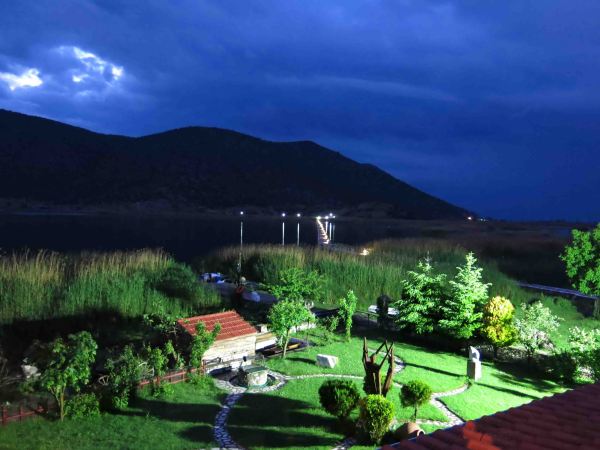
The view from Aghios Achillios hotel balcony in the evening with the lamps on the causeway glittering in the dark
For the more adventurous there is the most perfectly located hotel that offers great food and simple accommodation. Then at night you can ‘enjoy’ the extraordinary soundscape of this floating heaven. A powerful mixed chorus of great reed warblers and pond frogs overwhelms the darkness and is softened by the songs of nightingales. It is bio-luxuriance for the ear.
In the morning, as the sun rises over the eastern mountains, Aghios Achillios is a glorious location in which to take in the whole of this huge international landscape. Squacco and purple herons and occasional glossy ibises can be found feeding at close range in the quiet bays by the hamlet. Yet all Prespa’s waterbirds are passing low overhead in a non-stop traffic, while the limestone meadows are thick with spring flowers. It reminds me strongly of my childhood and the Derbyshire dales, except that the morning dew often bears the plodding tracks of Hermann’s tortoises.
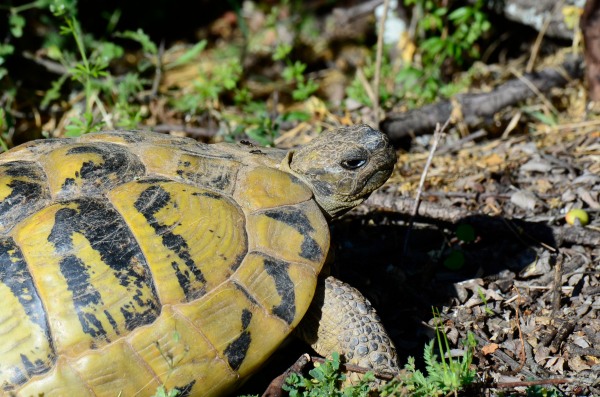
Hermann’s tortoises are common on the island and elsewhere
If you are interested in more than just birds then I should mention that Prespa is fabulous for other groups, with at least 40 mammal species, 30 amphibians and reptiles and nine endemic fish. In fact the omnipresence of life in extraordinary abundance is the signature experience at this wetland.
Then there is the ever-changing light. Often it is enough to sit on Krina as the sun comes up and watch the water changing hue. For me it is one of the most magical locations in all Europe. That rogue of twentieth century American letters Henry Miller once wrote in his strongly recommended The Colossus of Maroussi:
‘Greece is not a small country – it is impressively vast. No country I have visited has given me such a sense of grandeur. Size is not created by mileage always. In a way which it is beyond the comprehension of my fellow countrymen to grasp Greece is infinitely larger than the United States. Greece could swallow both the United States and Europe. Greece is a little like China and India. It is a world of illusion.’
Sitting on Krina and soaking it all up, I have a sense of what Miller meant. Greece is truly a big country.
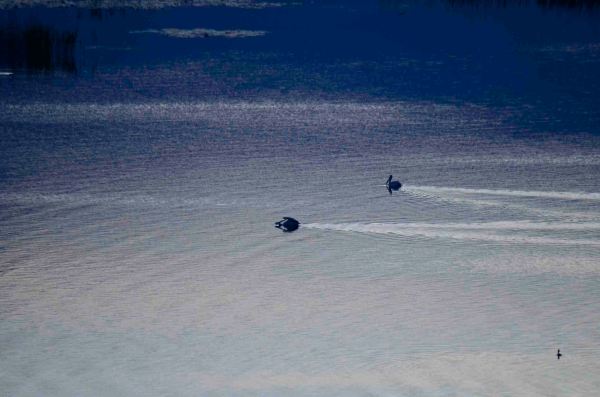







Andy Simpson
/ May 25, 2018Sounds amazing. You clearly travel there often but when would you say is the best time to visit ,for someone new to the area?
mark cocker
/ May 25, 2018Now Andy until the end of next month are fabulous but truthfully i have enjoyed all my visit.
Andy Simpson
/ May 26, 2018Thanks. Too much going on in Suffolk right now, but I shall certainly add Prespa to my wishlist. Andy
glorybeeblog
/ May 26, 2018Oh Mark, it’s positively mouthwatering! I can’t wait. Thank you for that little taster of what’s to come. Do you know yet how you’re fixed for the next few days? If you would like a little break from your massive in-tray, would you and Mary like to come over to Ipswich? If you’re pushed for time and you’d rather we come to you, Monday evening would be the easiest as Isabelle is free then and can drive us (I came up by train), or else Janet and I could come to Norwich or some other convenient place by train. It’d be lovely to see you, but we’ll completely understand if it’s all too much. I know about overload from personal experience! Best love, Mxx
Sent from my Windows Phone ________________________________
margaret21
/ May 29, 2018What an exquisite, magical picture you paint.
mark cocker
/ May 29, 2018thanks Margaret21 that is v kind of you.